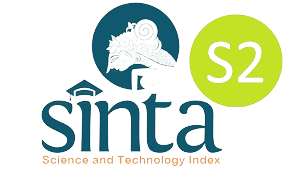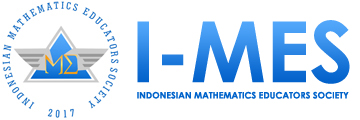Students' conceptual understanding of limit of functions reviewed from mathematical beliefs
DOI:
https://doi.org/10.29408/jel.v11i3.29144Keywords:
conceptual understanding, limit of functions, mathematics beliefAbstract
Conceptual understanding is a student’s cognitive structure characterised by the ability to transform and explain concepts in solving problems. Many students were unable to explain the concepts and the relationships between concepts in solving the limit of functions. This study aimed to explore students' conceptual understanding of the limit of functions in terms of mathematical beliefs. The subjects were 30 mathematics education students at Syiah Kuala University who had taken calculus courses for advanced real analyses. Data were collected using questionnaires, tests, and interviews. Data processing was carried out by reducing data, presenting, analysing, and drawing conclusions. The results of the study showed that students with strong mathematical beliefs demonstrated a more complete and integrated conceptual understanding of the limits of functions, as they could connect concepts, procedures, and graphical representations. In contrast, students with medium and low mathematical beliefs tended to focus only on procedural knowledge, often failing to explain underlying concepts or make meaningful connections between concepts and problem-solving steps. Based on the results, calculus lecturers need to build a strong conception of the material on the real number system and real functions so that the concept of the limit of functions is easily understood and memorised.
References
Adhikari, K. P. (2020). Difficulties and misconceptions of students in learning limit. Interdisciplinary Research in Education, 5(1&2), 15–26. https://doi.org/10.3126/ire.v5i1&2.34731
Afgani, M. W., Suryadi, D., & Dahlan, J. A. (2017). Analysis of undergraduate students’ mathematical understanding ability of the limit of function based on apos theory perspective. Journal of Physics: Conference Series, 895(1), 012056. https://doi.org/10.1088/1742-6596/895/1/012056
Angel-Cuervo, Z. M., Briceño-Martínez, J. J., & Bernal-Ballén, A. (2024). Validation of a questionnaire to evaluate mathematics teachers’ beliefs about mathematics, teaching, and learning. Eurasia Journal of Mathematics, Science and Technology Education, 20(5), 1–15. https://doi.org/10.29333/ejmste/14447
Arnal-Palacián, M. (2022). Infinite limit of a function at infinity and its phenomenology. Annales Universitates Paedagogicae Cracoviensis. Studia Ad Didacticam Mathematicae Pertinentia, 14, 25–41. https://doi.org/10.24917/20809751.14.3
Arsyad, N., Ramadhana, Y., & Assagaf, S. F. (2021). Students’ factual understanding on the concept of limit. Journal of Physics: Conference Series, 1899(1), 012148. https://doi.org/10.1088/1742-6596/1899/1/012148
A’zima, R., Roza, Y., & Maimunah. (2019). Analisis kemampuan pemahaman konsep matematis siswa dalam menyelesaikan soal limit fungsi [Analyzing students’ conceptual understanding in solving problems on function limits]. 7(2), 12–18.
Beynon, K. A., & Zollman, A. (2015). Lacking a formal concept of limit: advanced non-mathematics students’ personal concept definitions. The Research Council on Mathematics Learning, 8(1), 47–62.
Busetto, L., Wick, W., & Gumbinger, C. (2020). How to use and assess qualitative research methods. Neurological Research and Practice, 2(14), 1–10. https://doi.org/10.1186/s42466-020-00059-z
Byerley, C., & Thompson, P. W. (2017). Secondary mathematics teachers’ meanings for measure, slope, and rate of change. Journal of Mathematical Behavior, 48, 168–193. https://doi.org/10.1016/j.jmathb.2017.09.003
Cifarelli, V., Goodson-espy, T., & Chae, J. (2010). Associations of students’ beliefs with self-regulated problem solving in college algebra. Journal of Advanced Academics, 21(2), 204–232.
Dündar, S. (2015). Mathematics teacher- candidates’ performance in solving problems with different representation styles: the trigonometry example. Eurasia Journal of Mathematics, Science and Technology Education, 11(6), 1379–1397. https://doi.org/10.12973/eurasia.2015.1396a
Faizah, H. (2019). Profil pemahaman konseptual mahasiswa calon guru matematika tentang grup ditinjau dari kemampuan matematika [Prospective mathematics teachers’ conceptual understanding of groups based on their mathematical ability]. 4185, 84–97.
Feudel, F., & Biehler, R. (2022). Students ’ understanding of the economic interpretation of the derivative in the context of marginal cost. 437–468.
Gebeyehu, M., Atnafu, M., & Ejigu, T. (2021). Implementing geogebra integrated with multi-teaching approaches guided by the apos theory to enhance students ’ conceptual understanding of limit in ethiopian universities. Heliyon, 7(5), e07012. https://doi.org/10.1016/j.heliyon.2021.e07012
Huberman. (2014). Qualitative data analysis (H. Salmon, Ed.; 3rd ed.). SAGE Publication.
Jones, S. R. (2015). Calculus limits involving infinity: the role of students’ informal dynamic reasoning. International Journal of Mathematical Education in Science and Technology, 46(1), 105–126. https://doi.org/10.1080/0020739X.2014.941427
Klau, K. Y., Siahaan, M. M. L., & Simarmata, J. E. (2020). An identification of conceptual and procedural understanding: study on preservice secondary mathematics teacher. Al-Jabar : Jurnal Pendidikan Matematika, 11(2), 339–350. https://doi.org/10.24042/ajpm.v11i2.7310
Kristanto, Y. D., Melissa, M. M., & Panuluh, A. H. (2019). Discovering the formal definition of limit through exploration in dynamic geometry environments. Journal of Physics: Conference Series, 1180(1), 012004. https://doi.org/10.1088/1742-6596/1180/1/012004
Laja, Y. P. L. (2022). Analisis kesulitan mahasiswa pendidikan matematika dalam menyelesaikan soal limit trigonometri [Analyzing the difficulties of mathematics education students in solving trigonometric limit problems]. 11, 37–48.
Maries, A., Lin, S.-Y., & Singh, C. (2016). The impact of students’ epistemological framing on a task requiring representational consistency. 212–215. https://doi.org/10.1119/perc.2016.pr.048
Motseki, P., & Luneta, K. (2024). An error analysis of TVET students’ responses to optimisation problems. African Journal of Research in Mathematics, Science and Technology Education, 28(1), 134–152. https://doi.org/10.1080/18117295.2024.2341358
Muhtarom, M., Juniati, D., Siswono, T. Y. E., & Rahmatika, I. (2018). Teachers’ and students’ beliefs in mathematics at State Senior High School 5 Semarang. Jurnal Riset Pendidikan Matematika, 5(1), 64–72. https://doi.org/10.21831/jrpm.v5i1.18734
NCTM. (2020). Standards for the Preparation of Secondary Mathematics Teachers. The National Council of Teachers of Mathematics, Inc., May, 1–84.
Nurdin, Assagaf, & Arwadi. (2019). Students ’ understanding on formal definition of limit students ’ understanding on formal definition of limit. https://doi.org/10.1088/1742-6596/1752/1/012082
Oktaviyanthi, R., Herman, T., & Dahlan, J. A. (2018). How does pre-service mathematics teacher prove the limit of a function by formal definition ? 9(2), 195–212.
Ozturk, T., & Guven, B. (2016). Evaluating students’ beliefs in problem solving process: A case study. Eurasia Journal of Mathematics, Science and Technology Education, 12(3), 411–429. https://doi.org/10.12973/eurasia.2016.1208a
Prendergast, M., Breen, C., Bray, A., Faulkner, F., Carroll, B., Quinn, D., Carr, M. (2018). Investigating secondary students beliefs about mathematical problem-solving. International Journal of Mathematical Education in Science and Technology, January. https://doi.org/10.1080/0020739X.2018.1440325
Putri, D., Usodo, B., & Subanti, S. (2022). Students’ mathematical conceptual understanding : What happens to proficient students ? 2017(November).
Saleh. (2018). Pemahaman mahasiswa pada konsep limit fungsi berdasarkan kemampuan matematika [Understanding of function limit concepts among students based on their mathematical ability]. 1(x), 191–196.
Sari, P. (2017). Geogebra as a means for understanding limit concepts. Southeast Asian Mathematics Education Journal, 7(2), 71–84. https://doi.org/10.46517/seamej.v7i2.55
Sebsibe, A. S., Bekana, T., & Dorra, T. (2019). Effect of error analysis and concept change strategy on students understanding of calculus concepts. IEEE-SEM, 7(7), 369–385. https://www.researchgate.net/publication/349073918
Sebsibe, A. S., & Feza, N. N. (2020). Assessment of students’ conceptual knowledge in limit of functions. International Electronic Journal of Mathematics Education, 15(2), 1–15. https://doi.org/10.29333/iejme/6294
Soesanto, R. H., Putri, K., & Dirgantoro, S. (2021). Kemampuan pemecahan masalah mahasiswa pada kalkulus integral dilihat dari keyakinan dan pengetahuan awal matematis [Students’ problem-solving ability in integral calculus viewed from mathematical beliefs and prior knowledge]. 7(1), 117–129. https://doi.org/10.29408/jel.v7i1.2899
Sulastri, R., Suryadi, D., Prabawanto, S., Cahya, E., & Fitriani, F. (2022). Zone of concept image differences in infinite limits at undergraduate level. Jurnal Didaktik Matematika, 9(1), 1–21. https://doi.org/10.24815/jdm.v9i1.24709
Szydlik, J. E. (2000). Mathematical beliefs and conceptual understanding of the limit of a function. 31(3), 258–276.
Tamba, K. P., Appulembang, O. D., & Listiani, T. (2022). Korelasi antara keyakinan belajar dan pemahaman konseptual kalkulus pada calon guru matematika [The correlation between learning beliefs and conceptual understanding of calculus in prospective mathematics teachers]. JNPM (Jurnal Nasional Pendidikan Matematika), 6(1), 20. https://doi.org/10.33603/jnpm.v6i1.5315
Tanjung, J. Y., Ade, R., Simanjuntak, P., Manullang, J. C., Turnip, L., & Simanullang, M. C. (2025). Analisis kesalahan mahasiswa dalam menyelesaikan soal limit fungsi berdasarkan teori kastolan [Analyzing mathematics students’ errors in solving function limit problems using kastolan’s theory]. Mandalika Mathematics and Education Journal, 5, 391. https://doi.org/10.29303/jm.v3i1.9014
Usman, Bambang, R. M., Hasbi, S. M., & Mardhiah, M. Z. (2020). Analysis of calculus learning beliefs and students’ understanding about limit of functions: a case study. Journal of Physics: Conference Series, 1462(1), 012024. https://doi.org/10.1088/1742-6596/1462/1/012024
Usman, Juniati, D., & Siswono, T. Y. E. (2017). Exploration the conception of prospective students teacher about limit of function. AIP Conference Proceedings, 1868(August). https://doi.org/10.1063/1.4995162
Wabula, J. D., & Cahyono, E. (2017). Analisis pemahaman konsep limit fungsi pada siswa sma berdasarkan jenis kelamin [Analyzing high school students’ conceptual understanding of function limits in relation to gender differences]. Seminar.Uny.Ac.Id, 191–196.
Wakhata, R., Balimuttajjo, S., & Mutarutinya, V. (2023). Enhancing the learning of limits of functions using multiple representations. Mathematics Teaching Research Journal, 5(2), 182–202.
Wewe, M. (2020). The profile of students’ learning difficulties in concepts mastery in calculus course. Desimal: Jurnal Matematika, 3(2), 161–168. https://doi.org/10.24042/djm.v3i2.6421
Winarso, W., & Toheri, T. (2017). A case study of misconceptions students in the learning of mathematics: The concept limit function in high school. 4(1), 120–127.
Yoon, B., & Uliassi, C. (2022). “researcher-as-instrument” in qualitative research: The complexities of the educational researcher’s identities. Qualitative Report, 27(4), 1088–1102. https://doi.org/10.46743/2160-3715/2022.5074
Downloads
Published
How to Cite
Issue
Section
License
Copyright (c) 2025 Usman, Aiyub, M. Hasbi

This work is licensed under a Creative Commons Attribution-ShareAlike 4.0 International License.
Authors who publish with the Jurnal Elemen agree to the following terms:
- Authors retain copyright and grant the journal right of first publication with the work simultaneously licensed under Creative Commons Attribution-ShareAlike 4.0 International License (CC BY-SA 4.0).
- Authors are able to enter into separate, additional contractual arrangements for the distribution of the journal's published version of the work (e.g., post it to an institutional repository or publish it in a book), with an acknowledgment of its initial publication in this journal.
- Authors are permitted and encouraged to post their work online (e.g., in institutional repositories or on their website) prior to and during the submission process, as it can lead to productive exchanges, as well as earlier and greater citation of published work.
Jurnal Elemen is licensed under a Creative Commons Attribution-ShareAlike 4.0 International License





